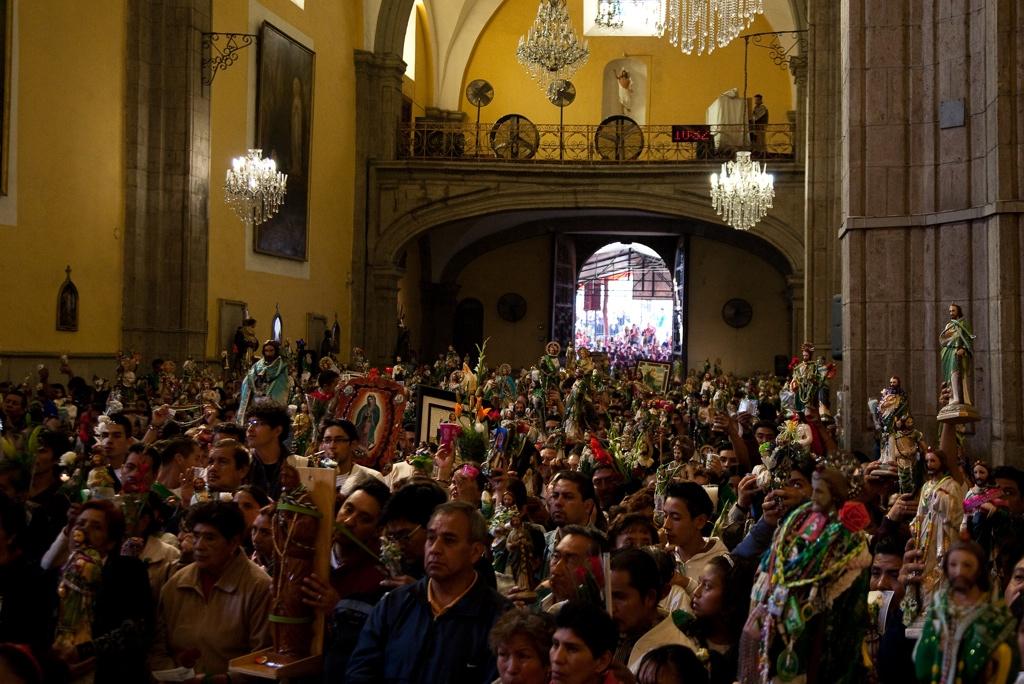Mexico’s San Judas packs churches with motley crowd
San Judas, or St Jude, draws huge crowds bearing statues and images of their patron once a month in Mexico City.
MEXICO CITY — As dusk falls outside this city’s colonial-era Temple of San Hipolito, Daniel struggles to carry a life-size statue of San Judas Tadeo. He stumbles through a vibrant crowd of food sellers and believers who come out on the 28th of each month to pay their dues to the saint.
With slightly glazed, squinted eyes, Daniel, a 27-year-old beer vendor, tries to explain his devotion. He tugs nervously at his baggy black jeans and cocks his hat further to the side, before finally stammering a response.
“San Judas does favors for me, so I come down here. He makes sure I have work, and that I stay in good health. That’s why I bring him here, to say thanks.”
His friend Jesus (who, like Daniel, asked only to be identified by his first name) says he too owes a lot to the saint he’s been worshipping each month for the past six years.
“I was taking drugs, robbing people, walking down a bad path. I’ve turned things around, thanks to [San Judas],” Jesus says. “Two or three times, he’s fulfilled some important requests I made.”
Read more: Guatemala wants to legalize it
Thousands descend on the church on the 28th of every month in one of this largely Roman Catholic country’s unique blends of religious doctrine and folk and street culture.
But many Judas devotees might not seem like conventional churchgoers.
“At the services we see Christians, very devout Catholics, and people who participate very seriously in their roles as citizens,” says Padre Jose de Jesus Aguilar, director of radio and television for the Archdiocese of Mexico.
“But we also see an extreme group of people who you can’t really call Catholics, but who use the symbol of San Judas to commit all kinds of acts that are completely against the notion of the faith — robberies, assaults, drug use, and that sort of thing,” he said.
One of the 12 apostles of Christ, Judas Tadeo — or Jude Thaddeus — has no connection to Judas Iscariot, whose betrayal led to Jesus’ death. The venerated San Judas is the “patron saint of lost causes.”
Read more: Occupy Mexico? How about ‘End the Drug War’?
Once a month, believers pack into the church for services offered on the hour from 5 a.m. to 10 p.m. Those who cannot squeeze in listen to the priest outside over speakers. As each service concludes, the devotees lift up their statues, amulets or images, creating a floating sea of San Judas.
The odd mix of San Judas worshippers bears some resemblance to some of Mexico’s popular cults such as Santa Muerte, or “holy death,” thought to be practiced by up to 3 million people. Generally associated with the country’s drug cartels, shrines to Santa Muerte attract gangsters and thieves, as well as gays and transvestites, alongside working-class families, who make up the bulk of believers.
Like Santa Muerte and Jesus Malverde — another saint of similar regard — most come to San Judas looking for help with simple goals: protection, good health and secure employment.
But while Santa Muerte worship is condemned by the church in Mexico, the strong affiliation to San Judas is accepted as an integral part of Mexico’s unique religious culture.
Heriberto Cenovia and his wife Bellarmina Velasco sell fruit in the Central de Abastos, a massive market amid the city’s urban sprawl. They’ve been coming on the 28th of almost every month since they met eight years ago.
More from GlobalPost: Latin America’s hidden growth story
While the family rarely attends Sunday mass, their young children now accompany them to San Hipolito monthly.
“A lot of young people come here to do drugs, and look for miracles,” Cenovia says, adding that this doesn’t bother him. “We don’t really come here looking for special favors. Really, we come out of tradition, to pay respect to San Judas, and ask that he watches out for the family.”
A papal visit to Mexico March 23 to 26 will skip over Mexico City. More liberal than the rest of the country, the legalized gay marriage and abortion here are among the issues said to have led Pope Benedict XVI to instead choose Guanajuato, a quaint city a few hours outside the capital.
Mexico has one of the world’s largest Catholic populations and the pope’s visit will be a massive event. But additional beliefs such as San Judas add local twists to traditional dogma. For some, this offers a deeper religious connection than the Vatican’s teachings.
Asked about the pope, Cenovia smiles and says it’s nice he is coming. But Cenovia and his wife say their true religious allegiance lies later in the month; they’ll be back to pay respects to San Judas come March 28.
We want to hear your feedback so we can keep improving our website, theworld.org. Please fill out this quick survey and let us know your thoughts (your answers will be anonymous). Thanks for your time!
